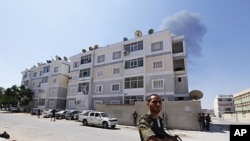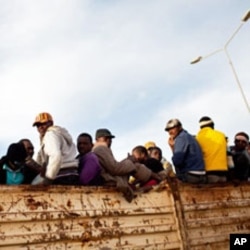As rebels occupied the compound of Moammar Gadhafi, international refugee and relief workers began efforts in Libya’s besieged capital to evacuate thousands of migrant workers by sea and to address the health and security needs of thousands more people in Tripoli.
Relief agencies say the next few days will be crucial to the safety of thousands of Libyans, migrant workers and political refugees in and around Tripoli and more than 50,000 Libyans elsewhere in the country uprooted by the violence of Libya’s revolution, according to relief workers.
“This is a country that has not witnessed conflict like this before,” said Robin Waudo, a spokesman for the International Committee of the Red Cross. ICRC, which has been working in several cities in western Libya, has been the only international relief agency working in Tripoli since April. The next to join was Medecins Sans Frontieres, which recently brought in surgical teams to serve wounded combatants and civilians in the city.
The ICRC team has a staff of 52 working in Tripoli and as far away as Sabha, 800 kilometers to the south. However, most of the Tripoli staff has not been able to leave their homes in recent days due to the heavy fighting.
“The urgent needs are to care for the wounded,” Waudo said. He listed other problems to be addressed in the coming days: disrupted water and sanitation systems, a severe shortage of medicines and vaccines, unexploded ordnance littering neighborhoods, and a large number of Libyans and third-country nationals detained by both sides of the conflict without charges filed or their families notified. The immediate need is to provide medicines, he said.
“We could see the impact of the conflict and of the sanctions that made it difficult for Libya to import drugs,” Waudo said. When the conflict began, the nation’s medical specialists, made up almost entirely of foreigners, left the country. Companies that imported 95 percent of Libya’s medicines also shut down. He said the greatest need so far is for more measles vaccines and diabetes medications.
Appeal for safe evacuation of Tripoli
A chartered vessel with a 300-person capacity has successfully docked in Tripoli after several days of anxious negotiations to evacuate third-country nationals from within and around the city. Some have boarded the ship, chartered by the International Organization for Migration, and others are being rounded up at several embassies, including the Philippine embassy. IOM hopes to have at least 200 refugees on board by dusk, when the ship leaves.
"Snipers and checkpoints around the city have proven to be the biggest challenge," an IOM official said as the first refugees boarded the ship. The organization plans to send additional ships to evacuate thousands more who remain in the city and its suburbs as rebel forces continue to encounter resistance from Gadhafi loyalists.
IOM officials are extremely concerned about security for the refugees, said Jemini Pandya, a spokesperson for the IOM in Geneva, Switzerland.
Last week, officials told IOM the port was safe. “We had been given all assurances that were needed for us to be able to carry out this operation when we dispatched the boat,” Pandya said. But control of the docks changed hands over the weekend as rebel forces took over from retreating Gadhafi supporters.
“We were informed that these security assurances were no longer valid in the sense that they could not be upheld for sure,” Pandya said.
The migrant worker challenge
According to the IOM spokesperson, migrants are currently scattered all over Tripoli and within the city’s embassy compounds. However, many of them, such as the sub-Saharan Africans, tend to live on the periphery of the city and don’t have access neither to the port nor to their embassies.
“Our worry is that given the security situation and the snipers and the checkpoints, migrant workers will not be able to leave wherever they are and make their way to the port. Which is why we are calling on all sides in this conflict to assure that the safety of migrants is assured… This is a crisis that doesn’t involve them, it is not a conflict that involves them. They are innocent parties to all of this and on a humanitarian level they should be allowed to leave the country safely,” said Pandya.
In a recent evacuation from Misrata, an unknown number of migrants who were camped out on the docks died in the shelling of the port.
Pandya says that IOM is appealing to both sides to guarantee the migrants’ safety so that what happened in Misrata will not be repeated.
Libyans returning home
As migrant workers escape the shooting in the capital, many Libyans who were internally displaced will want to return from the homes of family and friends in other parts of Libya and neighboring countries.
Refugees International estimates that 850,000 have fled Libya since February 11. Of that number, approximately 200,000 were Libyans. Matt Pennington of Refugees International says about 75 percent of them have returned, but another 50,000 are still displaced and will need protection and assistance.
Larger numbers of the internally displaced include Libyans and migrant workers, Pennington said. The numbers are changing daily. The UN has reported that there have been over 150,000 people displaced in the Nafusa Mountain Range area, but there are about 50,000 displaced in the Tripoli area, mostly from Misrata, and 50,000 to 60,000 in opposition-controlled areas in the east, said Pennington.
When the protests against the Gadhafi regime began on February 11, there were an estimated 300,000 non-Libyans living in the country. The largest numbers were Tunisians and Egyptians, most of whom have already returned home.
Nowhere to go
However, many of the third-country nationals who remain have nowhere else to go. “These are people with legitimate exit concerns,” Pennington said. “Of the 1600 or so refugees who are on the Tunisian border, for example, you have over 400 Somalis, over 600 Eritreans, a number of Sudanese and Ethiopians and actually a fairly large number of Iraqis.”
These refugees remain vulnerable to abuse by both sides in the conflict. “This is the place where we feel the U.S. government and these key donor governments of the U.K. and the French can put pressure on the National Transitional Council and the commanders on the ground to ensure that their forces on the ground protect these minorities,” said Pennington.
Meanwhile, tens of thousands of Libyans and their capital city remain at risk and it will be up to the international community to supply much of the assistance and expertise needed to offer them a more secure environment.
“Most of these folks are not staying in camps or in large settlements,” Pennington said. “They’re staying with host families, so really the focus needs for the international community, for the U.N., for the aid agencies needs to be on supporting these immediately vulnerable people and their host families. T he pressure on these families is immense when you have a family of eight and suddenly there are two families staying with them.”
Initial international relief efforts have encountered serious challenges in an uncertain political transition from 42 years under Moammar Gadhafi to rebel forces who seek to lead a nation suffering from immediate health and security challenges.












